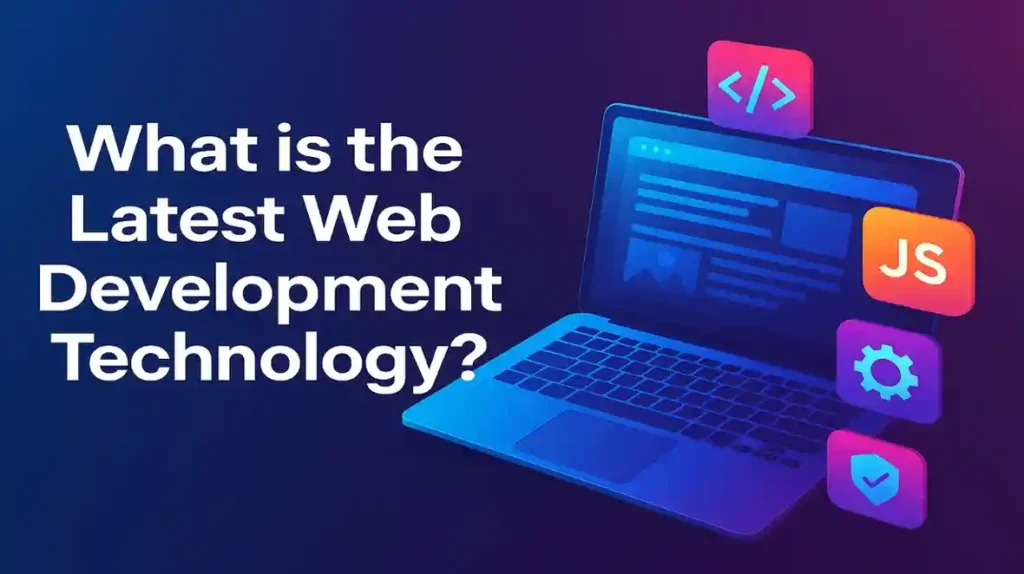
Introduction
Earlier, making a website was just HTML, CSS, and JavaScript. But now everything has changed, and with the era of AI has come, everything has changed.
Nowadays, internet lightning has become incredibly fast; people expect websites to load quickly, run smoothly, and function properly on mobile devices. This can be achieved by utilizing new tools and technologies in web development.
Now, every month, some new updates keep coming, and something new keeps happening in the world of technology.
In this blog, we will explore the web development scene in 2025, including the latest technologies that are gaining popularity and how these new tools are making websites faster, smarter, and more secure.
Read Also: Top 10 Free Digital Marketing Tools Every Beginner Should Use in 2025
The Evolution of Web Development
Talking about the earlier times, the websites used to be very simple, but now they have become smart, or you can say that many versions have come.
Web 1.0 (Static Era): Websites made with HTML/CSS only. No interactivity.
Web 2.0 (Dynamic & Social): Use of JavaScript, PHP, CMS (like WordPress). Blogs, social media, and user-generated content took shape.
Web 3.0 (Intelligent Web): The time of AI, blockchain, real-time data, and personalized UX. Focus on performance, security, and automation.
Today, websites are not just an online presence; they have become powerful tools — fast, responsive, and user-focused.
Top Web Development Technologies in 2025
By 2025, new changes are happening in web development, and new tools and trends have become advanced. We are sharing with you a list of some ideas in which you can see how the tools have made it advanced.
Jamstack Architecture: A Modern way to create fast, secure, and scalable websites.
WebAssembly (Wasm): For running high-performance code in the browser.
AI Tools: For smart coding assistants and personalized content generation.
Headless CMS (like Strapi): Flexible content management without design limits.
PWAs (Progressive Web Apps): App-like experience, without an app store.
Motion UI: Better UX with smooth animations and microinteractions.
Serverless & Edge Computing: Backend managed without servers — easy scale and fast delivery.
React Server Components (Next.js 14): Perfect combo of Frontend + backend for performance.
These additional technologies are making websites smarter and faster.
Why Keeping Up with New Technologies Matters
See, as technologies are getting upgraded, the demand for people is also increasing, so we must stay updated with new technologies because any new update is necessary to implement in that project, like better performance, user experience, or SEO benefits, which are important to rank in Google.
Better Performance: New technology makes websites fast, secure, and lightweight.
User Expectations: Users expect modern features and a seamless experience.
SEO Benefits: Google likes fast-loading, mobile-ready, and structured websites.
Time & Cost Saving: Latest tools make work easier through automation and faster workflows.
Competitive Edge: Whoever uses new tools stays ahead in the market.
The tech world changes every month. If we are not updated, we remain behind
How to Choose the Right Tech Stack
Now, let us talk about how we choose the right tech stack. The right tech stack means selecting a perfect combo of tools for any project. Because every project is different and not the same, therefore, we cannot follow any trend linearly, and things can be wrong too. How do we select it? I am giving a list here, you can see it.
Project Requirements: Do you want a static website or a dynamic one? Is it a blog or a full e-commerce?
Scalability: Will the tech be able to handle it in the future or not? (e.g., Node.js for real-time apps)
Team Expertise: The tech team that is already there will work fast.
Community & Support: Popular frameworks (like React, Django) help easily.
Security: Are the framework or tools updated and secure or not?
Budget & Time: Using Serverless or CMS can save a lot of cost and time.
Smart selection = smooth development + fewer headaches later.
Future Trends to Watch
The future of the world of web development is becoming even more exciting! You just need to keep up to date with those updates, and now the time of AI has arrived, so make sure that you get a call and a prompt; only then will you be able to use AI properly. Below I have given a list of some things in web development and in other fields, you can see them which will be helpful for you.
AI-Powered Development: Code suggestions, content generation, even full-page design — everything is becoming faster with AI.
Voice Search Optimization: It is becoming necessary to optimize websites for voice assistants.
Web 3.0 & Decentralization: The trend of blockchain-based websites and user-owned data is growing.
AR/VR Experiences: Especially for e-commerce and education, immersive interfaces are in demand.
No-Code/Low-Code Platforms: Non-developers are now able to create websites using tools.
Cybersecurity Focus: More emphasis is being given to built-in security features to avoid data breaches.
These trends will keep you ready for 2025 as well!
Conclusion
So, friend, I hope you liked this article. Web development is no longer limited to just writing code. It has become a very dynamic and fast-evolving field. Every year, something new comes up. New tools come up. New challenges also come up. Whether you are a website developer or a website owner, you must keep learning about the new trends and updates. Whether it is learning AI tools, setting up multiple systems, or future technology like Web 3.0, the one who learns, wins. So, learning must continue. And yes, there is no need to be afraid of technology – make friends with it.
- What Is the Google Search Console Used For? 15 Real Examples Every Website Owner Should Know - November 18, 2025
- Top 10 Free Tools to Reduce Image Size Without Losing Quality (2025) - November 17, 2025
- What Are the Advantages of WebP Format? (Real Examples + Before-After Results) - November 16, 2025
